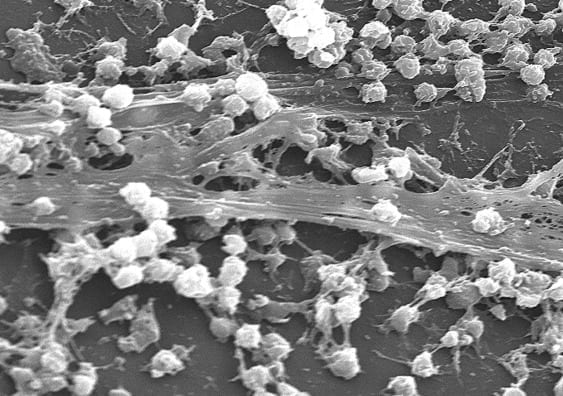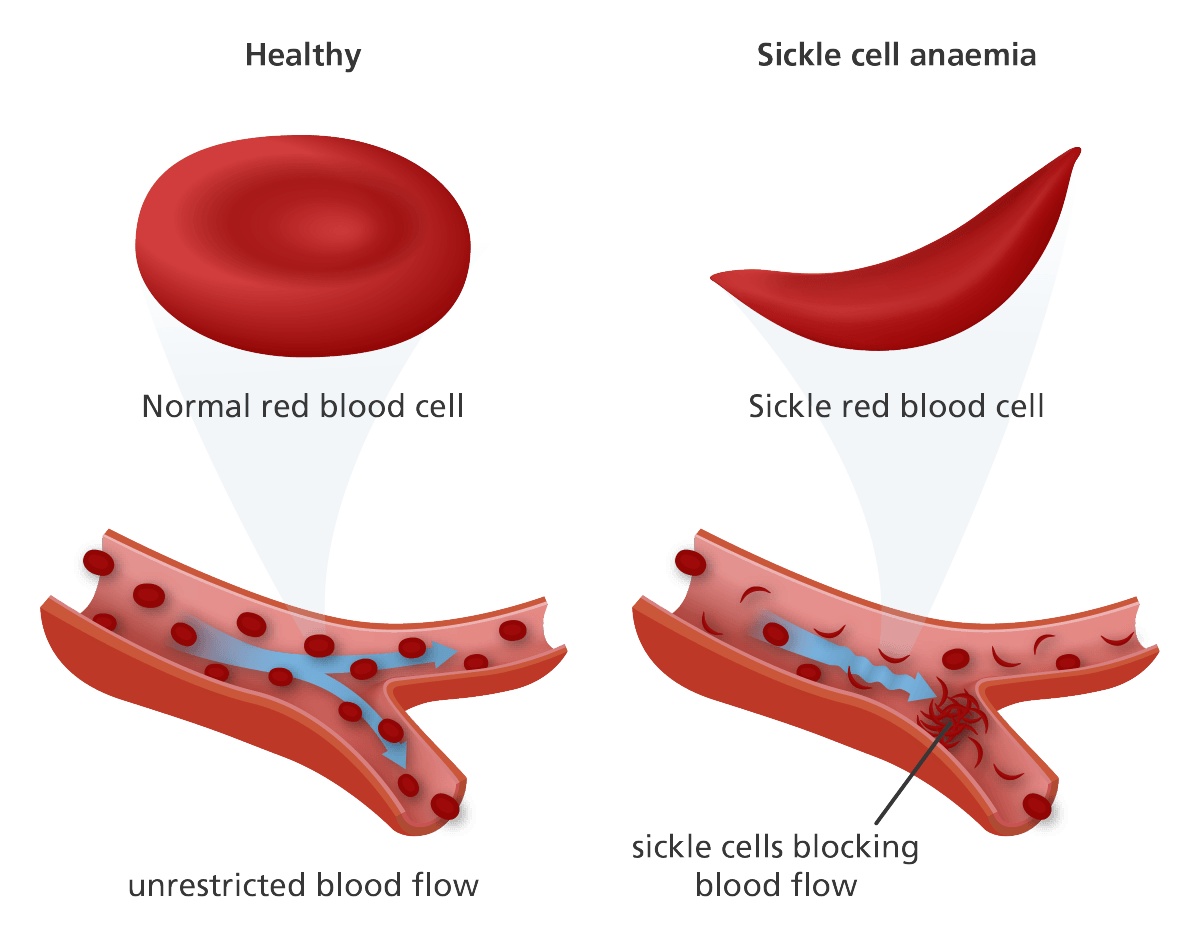
One of the scourges of hospital infections – biofilms formed by bacteria that stick to living tissue and medical instruments – can be tricked into dispersing with the targeted application of nanoparticles and heat.
The University of New South Wales study, jointly led by Associate Professor Cyrille Boyer of the School of Chemical Engineering and deputy director of Australian Centre for NanoMedicine, appears in today’s issue of Nature’s open access journal Scientific Reports.
“Chronic biofilm-based infections are often extremely resistant to antibiotics and many other conventional antimicrobial agents, and have a high capacity to evade the body’s immune system,” said Associate Professor Boyer. “Our study points to a pathway for the non-toxic dispersal of biofilms in infected tissue, while also greatly improving the effect of antibiotic therapies.”
Biofilms have been linked to 80% of infections, forming on living tissues (eg. respiratory, gastrointestinal and urinary tracts, oral cavities, eyes, ears, wounds, heart and cervix) or dwelling in medical devices (eg. dialysis catheters, prosthetic implants and contact lenses).
The formation of biofilms is a growing and costly problem in hospitals, creating infections that are more difficult to treat – leading to chronic inflammation, impaired wound healing, rapidly acquired antibiotic resistance and the spread of infectious embolisms in the bloodstream.
They also cause fouling and corrosion of wet surfaces, and the clogging of filtration membranes in sensitive equipment – even posing a threat to public health by acting as reservoirs of pathogens in distribution systems for drinking water.
In general, bacteria have two life forms during growth and proliferation: planktonic, where bacteria exist as single, independent cells; or aggregated together in colonies as biofilms, where bacteria grow in a slime-like polymer matrix that protects them from the environment around them.
Acute infections mostly involve planktonic bacteria, which are usually treatable with antibiotics. However, when bacteria have had enough time to form a biofilm – within a human host or non-living material such as dialysis catheters – an infection can often become untreatable and develop into a chronic state.
Although biofilms were first recognised in the 17th century, their importance was not realised until the 1990s, when it became clear that microbes exist in nature more often in colonies made up of lots of different microorganisms that adhere to surfaces through slime excreted by their inhabitants. Thus began a global race to understand biofilms, at a time when it was also realised they were responsible for the majority of chronic infections.
The discovery of how to dislodge biofilms by the UNSW Faculty of Engineering team – jointly led by Dr Nicolas Barraud, formerly of UNSW and now at France’s Institut Pasteur – was made using the opportunistic human pathogen Pseudomonas aeruginosa. This is a model organism whose response to the technique the researchers believe will apply to most other bacteria.
When biofilms want to colonise a new site, they disperse into individual cells, reducing the protective action of the biofilm. It is this process the UNSW team sought to trigger, making the bacteria again susceptible to antimicrobial agents.
Once dispersed, the bacteria are easier to deal with – creating the potential to remove recalcitrant, antimicrobial-tolerant biofilm infections.
The UNSW team found that by injecting iron oxide nanoparticles into the biofilms, and using an applied magnetic field to heat them – which induces local hyperthermia through raising the temperature by 5°C or more – the biofilms were triggered into dispersing.
Read more: Nanotech weapon against chronic bacterial infections
The Latest on: Chronic bacterial infections
[google_news title=”” keyword=”Chronic bacterial infections” num_posts=”10″ blurb_length=”0″ show_thumb=”left”]
via Google News
The Latest on: Chronic bacterial infections
- Why Your Breast Hurts in a Specific Spoton May 7, 2024 at 2:28 pm
Experiencing pain or discomfort in the breasts is a common concern for many individuals. Several factors, ranging from hormonal fluctuations to more serious conditions like breast cancer, can ...
- Whooping cough cases ‘could reach 40-year high’ in 2024, experts warnon May 7, 2024 at 10:30 am
Cases of whooping cough could reach a 40-year high in 2024, experts have warned amid a rapid rise in cases. The number of cases of whooping cough in England was higher in February than in the whole of ...
- Longest-Ever COVID Infection Lasted More Than 600 Dayson May 1, 2024 at 6:30 am
A Dutch man with lymphoma and other blood disorders was infected with the COVID-causing virus for nearly two years, during which time the pathogen evolved numerous mutations ...
- US Dog Owners Warned Against Widespread Deadly Bacterial Illnesson May 1, 2024 at 12:46 am
Despite availability of an effective vaccine, veterinarian Emmanuelle Butty still sees dogs with the serious disease.
- Gut bacteria and urinary infections linked, offering new angles for treatmenton April 30, 2024 at 7:25 pm
A study in eClinicalMedicine explores the relationship between gut microbiota, urinary tract colonization, and recurrent urinary tract infections (rUTI), suggesting the cross-habitation of ...
- What is Shigella? As infections caused by sexual transmission riseon April 30, 2024 at 6:34 am
With a rise in antibiotic-resistant cases across the UK, here's everything you need to know, from how you get Shigella to how you can test for it and treat it.
- No Antibiotics Needed – Revolutionary Chronic Wound Treatment Could Help Millionson April 28, 2024 at 1:29 am
An international team of scientists has developed a new treatment for chronic wounds that uses ionized gas to activate a wound dressing, without the need for antibiotics. The treatment involves the pl ...
- Parotitis (Parotid Gland Swelling)on April 26, 2024 at 5:00 pm
Chronic bacterial parotitis may be caused ... the provider may send a sample for medical analysis to test for a bacterial infection and confirm bacterial parotitis. Treatments for Parotitis ...
- New UTI vaccine wards off infection for years, early studies suggeston April 26, 2024 at 12:39 pm
More than 50% of the patients who used a new mouth-spray-based vaccine didn't have a UTI for up to nine years.
- Superbug from human eye drops outbreak spread to dogson April 26, 2024 at 11:19 am
The animals were infected by a bacteria ... try to diagnose a chronic cough. From the other dog, veterinarians had been trying to figure out the culprit of a stubborn ear infection.
via Bing News










